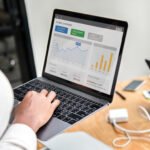The most successful brands in the present day do not simply have marketing campaigns that quantify everything. The unspoken rule of thumb of any successful online marketing strategy has been data analytics. The gap between the guess and the know is data, whether it is the optimization of Google Ads in Dubai, the making of Instagram campaigns in Abu Dhabi, the organization of regional eCommerce.
Unpacking how you would use data analytics to make your approach to digital marketing different and how you can use it to make smarter and more profitable campaigns, let’s unpack how using data analytics would help you change the way you approach digital marketing.
Why Data Analytics is Important in Digital Marketing
In its most simplistic form, data analytics in marketing refers to the employment of figures and patterns of behavior to inform all marketing decisions such as how much an advertisement is going to spend and which creative approach is favored.
To the UAE companies that have to compete in a rapidly expanding digital economy, analytics is not a luxury. It’s essential.
Here’s why:
- It substitutes assumptions with knowledge. As opposed to using gut instinct, analytics reveals the specifics of what works.
- It improves targeting. You are able to find out what sections of the audience actually make conversion and which ones scroll through.
- It boosts ROI. All the money that you spend on things is recorded and this aids you to make better budgets.
Suppose you are running a campaign of a brand in Dubai. And you have likes and impressions without analytics. Through it, you are aware that, mobile plays a role in 65% of your conversions among women aged 25-34 who are mostly using it at night. That’s the power of data.
The top Marketing KPIs Every Brand Should track
In order to ensure that analytics is handy, you must measure the correct things. These measures are referred to as marketing KPIs (Key Performance Indicators): they are the beating heart of your campaigns.
The following are the basics all business needs to follow:
- Conversion Rate: This is a percentage of how many visitors are taking action (buy, sign up, inquire).
- Click-Through Rate (CTR): The number of people that actually click on your ad or posting.
- Customer Acquisition Cost (CAC): The cost is the amount spent to attract a single new customer.
- Customer Lifetime Value (CLV): The cumulative income of a customer.
- Return on Ad Spend (ROAS): Revenue gained on each dirham spent on adverts.
- Engagement Rate: likes, shares, comments, however, more so quality engagements.
To the business in UAE, the measurement of these KPIs using such tools as Google Analytics 4, Meta Ads Manager, or HubSpot can be used, to be directly related to business performance.
Learning User behavior using Data
It is not all about numbers, analytics is about stories. There is a human being behind every action of clicking or conversion with their preferences and habits.
You can trace their path with the proper instruments.
Analytics tools such as Google Analytics 4, Hotjar, and Meta Insights show the behavior of users on your site or advertising, which pages they read, at what point they leave, and what motivates them to make a decision.
For example:
- A Dubai restaurant may get to know that the majority of online bookings are processed between 6 to 8 PM when users have a chance to see the menu page.
- A brand in eCommerce might find that traffic in Abu Dhabi is more converted via mobile than desktop.
When you know behavior you can customize experiences, alter landing pages and customize offers and optimize the experience to turn interest into revenue.
Predictive Analytics: Marketing Strategy of the Future
Predictive analytics will explain to you what will happen should descriptive analytics inform you about what happened.
The marketers can predict:
- Seasonal purchasing (such as Ramadan sales booms).
- Who are the ad creatives that will be the best?
- At the time customers are at the best chance to do repeat buying.
Concisely, predictive analytics would assist the UAE businesses to always be a step ahead, not responding to data, but knowing it.
That is specifically helpful when the market, such as Dubai, is changing its digital trends rapidly, and the timing will or will not make a campaign.
How to Fit Data Analytics into Your Marketing Workflow
The only way data is good is when you are aware of how to utilize it. Here’s a simple roadmap:
- Analyze: Pull data out of your systems and look at Google analytics, CRM, Ad Networks, email systems.
- Visualize: Visualize the numbers using Tableau, Zoho analytics or Google Data Studio.
- Analyze: Determine trends, areas of pain and opportunities.
- Act: Tweak campaigns, target smarter, and have wisdom in budget allocation.
- Repeat: Data analysis does not occur only once. Look and revise on a sustained basis.
The integration of HubSpot or Salesforce with ad and analytics platforms is an approach that many agencies in the UAE use to fuse marketing and sales data – providing a 360deg picture of customer performance.
Top Ten Catchfalls in Analytics
The finest tools may be misleading when used in the wrong way. The following are the pitfalls that should be avoided:
- Focusing on vanity metrics. Success is not always the one with high impressions and likes. Focus on conversions and ROI.
- Ignoring context. Contextless data may be misconstrued. Reduction in CTR would not be bad when conversions are increasing.
- Failure to take into account qualitative insights. Reviews, social sentiment and feedback of customers are also important.
- Inability to align analytics with objectives. Always attach metrics to actual business goals – not report numbers.
The idea is not to follow what is easy to follow but rather to follow what is important.
The Data-driven Marketing Power
Analytics changes the way you think about marketing when it is applied appropriately. You are not responding to the trends but you are setting them. You know your audience better, optimize on-the-fly, and make all of your decisions, which are supported by evidence, not guesses.
That is the way companies in Dubai, Abu Dhabi, and the Gulf are going smarter – getting more creative and at the same time more precise.
Information does not substitute gut feeling. It sharpens it.
FAQs
- What are marketing KPIs and what is their significance?
Marketing KPIs are metrics that will follow your campaign success – engagement all the way up to sales. They assist in determining what is working and what is not.
- What are the benefits of data analytics in enhancing digital marketing in the UAE?
Analytics offers information about audience behavior, trends in specific regions and campaign efficacy to enable marketers to enhance the strategies to generate higher returns.
- Which are the most appropriate campaign data tracking tools in Dubai?
The best ones are Google Analytics 4, HubSpot, Zoho Analytics, Tableau and Meta Ads Manager – all of these are used by agencies in the UAE.
- What is the frequency of data report analysis and updating by marketers?
It is best to review weekly on what campaigns are going on and do deeper analysis monthly or quarterly to see larger trends.
- How does descriptive and predictive analytics in marketing differ?
Predictive analytics is a future outlook of what will happen, whereas descriptive analytics examines the previous performance (what has happened).
And in such a technologically sophisticated nation as the UAE, marketing data analytics is no longer an option anymore, it is your competitive edge.
The winning brands today are those that apply analytics not only to monitor their performance, but also to know their viewer, to personalize content, and make smarter decisions.
Data in digital marketing can never be ignored as it is the basis of marketing.



